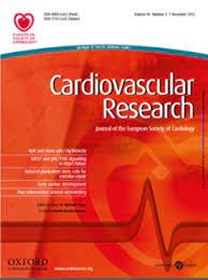Beta 2 adrenergic receptor gene methylation activates innate lymphoid cells to drive hypertension in lymphocyte deficient hosts.
IF 10.2
1区 医学
Q1 CARDIAC & CARDIOVASCULAR SYSTEMS
引用次数: 0
Abstract
AIMS T cells contribute to hypertension; however, hypertension occurs in settings of T cell deficiency. METHODS AND RESULTS We studied two colonies of T/B cell-deficient RAG-1-/- mice with disparate responses to angiotensin II, being one protected from blood pressure increase and the other one responsive. This difference depends on the capability of hypertensive RAG-1-/- mice to expand natural killer and innate lymphoid cells (NK/ILCs) that produce pro-hypertensive cytokines. This process is regulated by the DNA methylation status of the β2 adrenergic receptor (β2-AdR). Angiotensin II caused blood pressure elevation in T and NK/ILCs-deficient mice only when either T or NK/ILCs cells were adoptively reconstituted. Additional studies showed NK cell expansion in humans that underwent B cell depletion, and this was augmented in those with hypertension. CONCLUSIONS These findings illustrate that the modulation of NK/ILCs activation by adrenergic signalling governs an escape mechanism in lymphocyte-deficient host, enabling the development of hypertension.β 2肾上腺素能受体基因甲基化激活先天淋巴样细胞驱动淋巴细胞缺陷宿主高血压。
AIMST细胞与高血压有关;然而,高血压发生在T细胞缺乏的情况下。方法和结果我们研究了两个对血管紧张素II有不同反应的T/B细胞缺陷的rag1 -/-小鼠菌落,其中一个对血压升高有保护作用,另一个对血压升高有反应。这种差异取决于高血压RAG-1-/-小鼠扩大产生促高血压细胞因子的自然杀伤细胞和先天淋巴样细胞(NK/ILCs)的能力。这一过程受β2肾上腺素能受体(β2- adr) DNA甲基化状态的调节。血管紧张素II仅在T或NK/ILCs细胞过继重建时引起T和NK/ILCs缺陷小鼠血压升高。进一步的研究表明,在经历B细胞消耗的人类中,NK细胞扩增,并且在高血压患者中扩增。结论肾上腺素能信号对NK/ILCs活化的调节在淋巴细胞缺陷宿主中起逃逸机制作用,从而导致高血压的发生。
本文章由计算机程序翻译,如有差异,请以英文原文为准。
求助全文
约1分钟内获得全文
求助全文
来源期刊

Cardiovascular Research
医学-心血管系统
CiteScore
21.50
自引率
3.70%
发文量
547
审稿时长
1 months
期刊介绍:
Cardiovascular Research
Journal Overview:
International journal of the European Society of Cardiology
Focuses on basic and translational research in cardiology and cardiovascular biology
Aims to enhance insight into cardiovascular disease mechanisms and innovation prospects
Submission Criteria:
Welcomes papers covering molecular, sub-cellular, cellular, organ, and organism levels
Accepts clinical proof-of-concept and translational studies
Manuscripts expected to provide significant contribution to cardiovascular biology and diseases
 求助内容:
求助内容: 应助结果提醒方式:
应助结果提醒方式:


